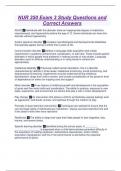NUR 350 Exam 3 Study Questions and
Correct Answers
ADHD ✅Individuals with this disorder show an inappropriate degree of inattention,
impulsiveness, and hyperactivity before the age of 12. Some individuals can have this
disorder without hyperactivity
Autism spectrum disorder ✅Complex neurobiological and developmental disabilities
that typically appear during a child's first 3 years of life.
Communication disorder ✅Deficits in language skills acquisition that create
impairments in academic achievement, socialization, or self-care. These include speech
disorders in which people have problems in making sounds or may stutter. Language
disorders result in difficulty understanding or in using words in context and
appropriately.
Intellectual disability ✅Previously called mental retardation, this is a disorder
characterized by deficits in three areas: intellectual functioning, social functioning, and
daily/practical functioning. Impairments must be evidenced during childhood
development, range from mild to severe, and include consideration of the person's level
of dependence on others for ongoing care and support
Motor disorder ✅A key feature of childhood growth and development is the acquisition
of gross and fine motor skills and coordination. The ability to practice, exposure to new
tasks, experience, and environment are factors that play a role in motor development.
Play therapy ✅An intervention that allows a child to symbolically express feelings such
as aggression, self-doubt, anxiety, and sadness through the medium of play.
Principle of least restrictive intervention ✅Techniques are selected to ensure that the
civil and legal rights of individuals are maintained - always use least restrictive first and
if this doesn't work then more restrictive
Resilience ✅The ability to adapt and cope that helps people to face tragedies, loss,
trauma, and severe stress.
Specific learning disorder ✅Identified during the school years. A _________
_________ _________ is diagnosed when a child demonstrates persistent difficulty in
the acquisition of reading (dyslexia), mathematics (dyscalculia), and/or written
expression (dysgraphia), and his or her performance is well below the expected
performance of peers.
,Temperament ✅The style of behavior a child habitually uses to cope with the demands
and expectations of the environment.
Therapeutic games ✅Games the nurse can play with a child to facilitate the
development of a therapeutic relationship and provide an opportunity for conversation.
Younger, older ✅____________ children are more difficult to diagnose than
___________ children because of limited language skills and cognitive and emotional
development.... Children undergo more rapid psychological, neurological, and
physiological changes over a briefer period than adults.
Resilience, intelligence, supportive environment ✅Identify factors that help aid in
avoiding the development of mental disorders.
Insecure attachment, developmental problems, mental disorders ✅The caregiver's role
in shaping that relationship is of primary importance, and the nurse can intervene to
teach parents ways to modify their behaviors to improve the interaction. If there is
incongruence between parent and child temperament and the caregiver is unable to
respond positively to the child, there is a risk of __________ ________________,
_______________________ ________________, and future __________
___________.
Shyness, aggressiveness, rebelliousness ✅Discuss how the child's temperament can
be a predictor to substance use and abuse when they become adults - traits include
________, _________, ________
Resilient child ✅characteristics of a _____________ _________: Adaptability to
changes in the environment
Ability to form nurturing relationships with other adults when the parent is not available
Ability to distance self from emotional chaos
Good social intelligence
Good problem-solving skills
Ability to perceive a long-term future
Impact on child when they witness violence and abuse ✅Witnessing violence is
traumatizing and a well-documented risk factor for many mental health problems,
including depression, anxiety, PTSD, aggressive and delinquent behavior, drug use,
academic failure, and low self-esteem // Children who have experienced abuse are at
risk for identifying with their aggressor and may act out, bully others, become abusers,
or develop dysfunctional interpersonal relationships in adulthood.
Neglect ✅What is the most prevalent form of child abuse in the US?
, Bullying ✅____________ is also a risk factor for such problems as depression and
suicide disorder. Children may bully and act violently toward one another, and gang
involvement is a growing problem among adolescents
Mentally healthy ✅characteristics of a _________ __________ child: Trusts others
and sees his or her world as being safe and supportive
Correctly interprets reality and makes accurate perceptions of the environment and
one's ability to influence it through actions (e.g., self-determination)
Behaves in a way that is developmentally appropriate and does not violate social norms
Has a positive, realistic self-concept and developing identity
Adapts to and copes with anxiety and stress using age-appropriate behavior
Can learn and master developmental tasks and new situations
Expresses self in spontaneous and creative ways
Develops and maintains satisfying relationship
Mental illness, functional impairments ✅A child or adolescent with __________
________ is one whose progressive personality development and functioning are
hindered or arrested due to biological, psychosocial, and spiritual factors, resulting in
________________ _______________.
Regressions, bonding ✅A child or adolescent who does not have a mental illness
matures with only minor ____________________, coping with the stressors and
developmental tasks of life. Learning and adapting to the environment and __________
with others in a mutually satisfying way are signs of mental health
Hx of illness, medical/developmental/family hx, mental status, neurological ✅Identify
the essential assessment data that the nurse needs to obtain with the child / adolescent
Interviewing, screening, testing, observing, interacting, playing ✅Identify methods the
nurse use to collect assessment data with the child / adolescent
Assessment of child's mental status ✅Broad categories to assess include safety,
general appearance, socialization, activity level, speech, coordination and motor
function, affect, manner of relating, intellectual function, thought processes and content,
and characteristics of play
Developmental assessment ✅The __________________ _____________ provides
information about the child or adolescent's maturational level
Rewarding, reduce ✅Behavior modification involves ______________ desired
behavior to _____________ maladaptive behaviors
Restrictive techniques ✅____________________ _______________ (such as the use
of seclusion or physical restraints) are implemented to manage behavior and maintain
safety only when very severe or dangerous behaviors are exhibited.




